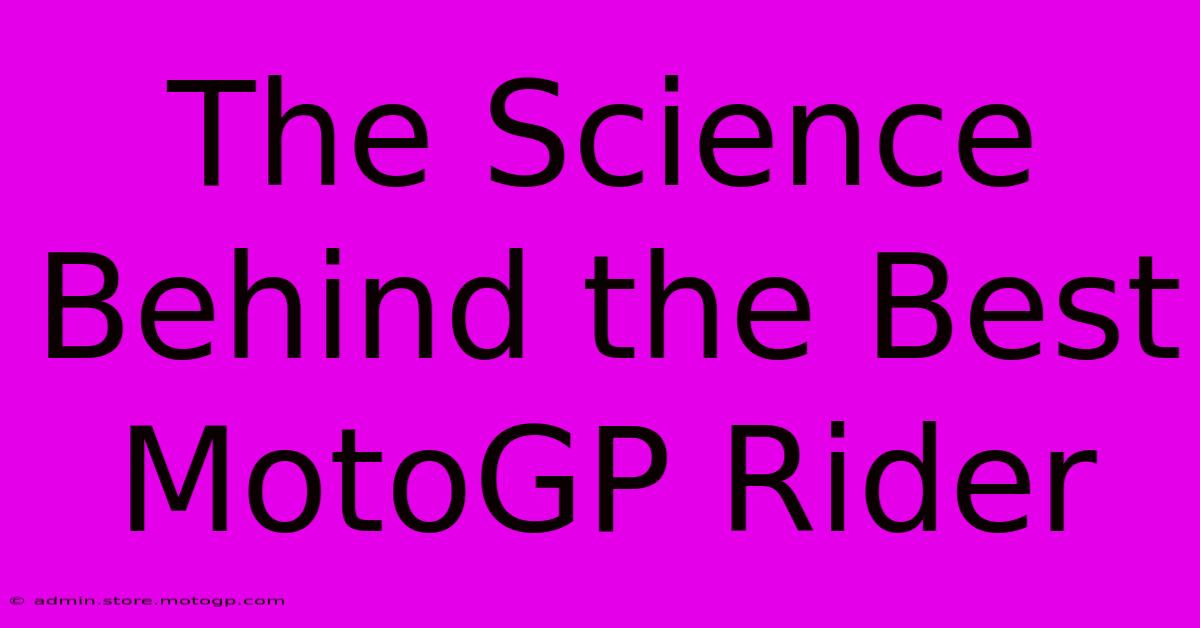The Science Behind The Best MotoGP Rider

Table of Contents
The Science Behind the Best MotoGP Rider
MotoGP. The pinnacle of motorcycle racing. The roar of the engines, the breathtaking speeds, the nail-biting overtakes – it all captivates millions. But beyond the spectacle lies a fascinating intersection of human performance and cutting-edge technology. What truly separates the best MotoGP riders from the rest? It’s not just about talent; it’s a complex interplay of physical prowess, mental fortitude, and a deep understanding of the science behind riding at the limit.
The Physical Demands: A Peak Athlete's Game
MotoGP riders aren't just racers; they're elite athletes. The physical demands are immense. Consider this:
- G-Forces: Riders endure extreme G-forces during acceleration, braking, and cornering. These forces can significantly impact the body, leading to fatigue and even loss of consciousness if not managed effectively. Strength training, specifically focusing on neck and core muscles, is crucial for withstanding these stresses.
- Endurance: A MotoGP race can last upwards of 45 minutes, demanding incredible stamina and cardiovascular fitness. Riders need to maintain peak performance throughout, despite the intense physical exertion and high temperatures. Extensive cardiovascular training and endurance exercises are essential.
- Precision and Dexterity: Operating a MotoGP machine requires exceptional fine motor control, precision, and reaction time. The rider must make minute adjustments to throttle, brakes, and body position, all while navigating a challenging track at breakneck speed. This demands specific training focused on hand-eye coordination and reaction speed.
- Body Awareness: A top rider possesses exceptional body awareness. They understand how their body interacts with the bike, instinctively making adjustments to maintain optimal control and balance. This heightened awareness comes from years of dedicated practice and a deep understanding of biomechanics.
Training Regimen: More Than Just Riding
The training regimen of a top MotoGP rider is rigorous and multifaceted. It goes far beyond simply riding a motorcycle:
- Strength and Conditioning: A well-structured program focuses on building strength, power, and endurance. Exercises target core strength, neck muscles, and overall body conditioning.
- Cardiovascular Training: Running, cycling, and swimming contribute to improving cardiovascular fitness and stamina.
- Flexibility and Mobility: Yoga and Pilates improve flexibility and range of motion, crucial for maintaining control and comfort during extended periods on the bike.
- Mental Training: Visualization, meditation, and stress management techniques are vital for maintaining focus and composure under pressure.
The Mental Game: Focus and Resilience
The mental aspect is equally crucial. Top riders possess:
- Exceptional Focus: Maintaining intense focus for extended periods amidst the chaos of a race is paramount. Distraction is the enemy.
- Resilience: Setbacks and crashes are inevitable. The ability to bounce back from adversity, learn from mistakes, and maintain a positive mental attitude is vital.
- Strategic Thinking: Race strategy plays a significant role. Top riders analyze track conditions, rivals' performances, and adjust their approach accordingly.
- Risk Management: Pushing the limits is inherent to MotoGP, but responsible risk management is also crucial. Understanding the threshold between pushing hard and crashing is key.
Technology's Role: Data-Driven Optimization
Modern MotoGP utilizes cutting-edge technology to enhance performance:
- Data Analysis: Telemetry data provides insights into rider performance, bike setup, and track conditions. This data is invaluable for optimizing strategy and improving technique.
- Ergonomics: Precise bike adjustments ensure optimal rider comfort and control. The rider's physique is central to this process.
- Training Simulations: Simulators allow riders to practice and refine their skills in a controlled environment.
- Advanced Materials: Lightweight, high-strength materials in bikes and riding gear contribute to improved performance and safety.
The Synthesis: A Holistic Approach
Becoming a top MotoGP rider isn't simply about natural talent; it's a holistic approach demanding a harmonious blend of physical conditioning, mental fortitude, and technological expertise. The science behind their success is a testament to the dedication, discipline, and unwavering pursuit of excellence that define these elite athletes. They are not just riders; they are the embodiment of human potential pushed to its absolute limits.

Thank you for visiting our website wich cover about The Science Behind The Best MotoGP Rider. We hope the information provided has been useful to you. Feel free to contact us if you have any questions or need further assistance. See you next time and dont miss to bookmark.
Featured Posts
-
Cota Parking Your Go To Guide For Parking At Cota
Feb 20, 2025
-
Get Your Tickets Now Malaysian Motorcycle Grand Prix
Feb 20, 2025
-
Formula 1 Parking Pass Your Gateway To The Grand Prix
Feb 20, 2025
-
Motorcycle Racing Demystified Understanding The Different Types
Feb 20, 2025
-
Cota Open Track Days Your Next Adventure Awaits
Feb 20, 2025
